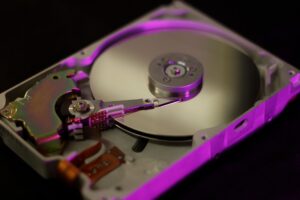Note : This page has been translated into English from French by a machine translation tool
The Cloud… Who hasn’t repeatedly heard this term come up in conversations ? Directly or indirectly, many users of digital products use a service that is or can be assimilated to it. As soon as you use an online messaging service, for example, you use, without necessarily being aware of it, a Cloud Computing service.
So what is Cloud Computing ? Cloud Computing is the act of accessing an IT service through a network or internet connection. To put it simply, we call IT service anything you could do with your personal computer but that you choose to delegate to a remote server and this for reasons that can be various. There are nowadays a large number of IT tasks that can be carried out using the Cloud.
What can be done with the Cloud and why use it ?
Let’s start with the use for which you are familiar with the Cloud generally, storage in this case. For example, you use the storage capacity of remote servers when you use a cloud computing solution such as Microsoft OneDrive to store your data, files, or a full backup of your system. This is shortened to STaaS, which stands for Storage as a Service. There are several reasons for making this choice. The first is that you do not store this data yourself, which by definition means that you do not have to significantly reduce or even completely mobilize your own storage space on your external devices or hard drives. But this is not the main interest here.
Indeed, storage space on your computer or hard drives is generally less expensive in the medium term than storage space in the Cloud except when it is included in a package with other services such as OneDrive with Office 365. The second and, in our opinion, most important reason is the one we mentioned in our article The software you will certainly need, namely that thanks to the Cloud, you separate your hardware from your data, thus ensuring that the latter will not disappear with it. The third reason, and not the least, is one of accessibility. STaaS providers allow you to access your content not only from your computer, but also very often from your mobile devices, which means that you have permanent access to this data, whenever you want and wherever you are. This is not the case with the data you store on your computer or hard drives unless you use NAS storage as your personal cloud.
So far we have only talked about storage, that is to say basically replacing the service offered by your hard disk with storage space on a remote server. However, a server is in fact just a computer with very large capacities (see our article The server infrastructure for more information). Therefore, you might not want to use your computer to run software for example. So you will use the Cloud for that. This is called SaaS, an acronym for Software as a Service. Here, software is installed on a remote server and it’s the server that provides the resources to run it. Your computer, for its part, simply receives the information to be displayed via a web browser for example. You see the interest? The first one, which is also the main one, is obvious. Allowing you to run an application that your computer could not run itself because of insufficient hardware resources. But it also gives you the possibility to leave most of the resources of your devices to perform other tasks for example. Finally, you usually don’t store these applications, which can be quite large. Again, you have saved storage space on your device. You tell yourself that the reasons why you would use the Cloud come together for the different services they offer. Of course you do… Here again, as with storage, the point is to be able to use your applications from any device.
So now it’s going to get a little more complicated, so we’ll try not to go into too much detail and give you simple explanations about the rest of the services offered through the Cloud.
Let’s go back to our previous example, you are using a software installed on a server. Now, we know that software installed on a computer needs an operating system to function as described in the article The Microsoft Windows operating system. And this operating system is also a set of software, so it can also be stored and run via the Cloud. This corresponds in this case to remotely host the equivalent of your computer. This is called the Virtual Desktop Infrastructure (see our Virtual Desktop Infrastructure article for more information). We have moved to DaaS, which stands for Desktop as a Service. Beware because DaaS can also refer to Data as a Service, which we’ll discuss briefly at the end.
Let’s take our chain up another notch. We just said that it was possible to store an operating system and all the software we need on a remote server. But then where do the operating system licenses come from? Then there are two possibilities. Either it is the service provider who provides you with the machines and therefore the resources to run the whole thing, who also provides you with the licenses and installs all this on these machines that he makes available to you. In this case, it is PaaS, an acronym for Platform as a Service. The service provider ensures the maintenance of the hardware, of course, but also of everything that is necessary in terms of applications and configuration so that you have access to one or more virtual computers on which you can immediately start working. He also takes care of updates and guarantees the security of the machines. To simplify, at this stage it is almost as if you had bought one or more commercially available computers and you had a computer specialist on hand throughout your use to ensure that your hardware stays up to date, is well protected and that you leave it to him to take care of everything if it breaks down.
What if I want to choose my own operating system and development environment ? Then that’s possible too. If, in our previous example, you forget the computer scientist for the software part but he just manages in case of mechanical failure and you buy one or more computers with completely empty hard disks, therefore without operating systems and without basic utilities to manage the peripherals, you fall into IaaS which means Infrastructure as a Service. Here, in concrete terms, you rent servers in a Data Center whose service provider will guarantee their operation, and that’s about it. They also take care of the virtualization layers that we also talk about in our article Virtual Desktop Infrastructure.
There are more and more services and many variants that are offered through the Cloud. One wonders what its limitations are. We have discussed DaaS in its meaning Data as a Service, which allows an enterprise to store and manage its data via a service offered by the Cloud. Again, the aim is to offload the storage and IT resources that this requires. There is also BPaaS or Business Process as a Service which consists of decentralizing business processes in the Cloud, NaaS for Network as a Service in order to virtualize networks, of which the famous VPN is an example, or CaaS for Communication as a Service. They are generally derivatives of the types of services we have detailed above.
The last one we will talk about, the WaaS for Workplace as a Service is no exception to this rule. Workplace as a Service is a model that is designed to adapt to the needs of companies with regard to their new habits but without altering the security of this data. More concretely, such a service would make it possible to ensure that an employee or a person authorized to access a company’s data from outside the premises and the internal network is not only equipped with a device that is secure, but also to ensure that the network connection from which he or she accesses it is also secure, in particular by using the location of the device in question.
As you can see, the Cloud is an extremely broad generic term that today encompasses a very large number of services that can be just as suitable for an individual user to store their vacation photos as it is for a company to host all or almost all of its IT resources in the Cloud. In the case of businesses, the question of choosing between a private and a public Cloud can also arise. Indeed, we have spoken here about service providers who can decentralize storage space or resources, and who also enable a service to be adapted to its needs: this is the Public Cloud. But you can very well decide to equip yourself with servers and storage space in order to host your own data and virtual machines, in this case we’re talking about Private Cloud. We invite you to read the following articles, some of which have already been mentioned previously to learn more…









… [Trackback]
[…] Find More Information here to that Topic: soft-hardware.fr/en/the-cloud/ […]
… [Trackback]
[…] Here you will find 91830 more Info on that Topic: soft-hardware.fr/en/the-cloud/ […]
… [Trackback]
[…] Find More Information here on that Topic: soft-hardware.fr/en/the-cloud/ […]
Your point of view caught my eye and was very interesting. Thanks. I have a question for you. https://www.binance.com/vi/register?ref=WTOZ531Y
… [Trackback]
[…] Information on that Topic: soft-hardware.fr/en/the-cloud/ […]
… [Trackback]
[…] Read More Information here on that Topic: soft-hardware.fr/en/the-cloud/ […]
… [Trackback]
[…] There you can find 88239 additional Information to that Topic: soft-hardware.fr/en/the-cloud/ […]
… [Trackback]
[…] Find More on that Topic: soft-hardware.fr/en/the-cloud/ […]
… [Trackback]
[…] Find More on on that Topic: soft-hardware.fr/en/the-cloud/ […]
… [Trackback]
[…] There you will find 55898 additional Info on that Topic: soft-hardware.fr/en/the-cloud/ […]
… [Trackback]
[…] Read More on to that Topic: soft-hardware.fr/en/the-cloud/ […]
… [Trackback]
[…] Find More Information here on that Topic: soft-hardware.fr/en/the-cloud/ […]
… [Trackback]
[…] Find More on on that Topic: soft-hardware.fr/en/the-cloud/ […]
… [Trackback]
[…] Find More here to that Topic: soft-hardware.fr/en/the-cloud/ […]
… [Trackback]
[…] Read More on that Topic: soft-hardware.fr/en/the-cloud/ […]
… [Trackback]
[…] Information on that Topic: soft-hardware.fr/en/the-cloud/ […]
… [Trackback]
[…] Read More on to that Topic: soft-hardware.fr/en/the-cloud/ […]
… [Trackback]
[…] Information to that Topic: soft-hardware.fr/en/the-cloud/ […]
… [Trackback]
[…] Information on that Topic: soft-hardware.fr/en/the-cloud/ […]
… [Trackback]
[…] Info to that Topic: soft-hardware.fr/en/the-cloud/ […]
… [Trackback]
[…] Read More Info here to that Topic: soft-hardware.fr/en/the-cloud/ […]
… [Trackback]
[…] Find More Info here on that Topic: soft-hardware.fr/en/the-cloud/ […]
… [Trackback]
[…] Information to that Topic: soft-hardware.fr/en/the-cloud/ […]
… [Trackback]
[…] Here you will find 25449 more Info on that Topic: soft-hardware.fr/en/the-cloud/ […]
… [Trackback]
[…] Info on that Topic: soft-hardware.fr/en/the-cloud/ […]
… [Trackback]
[…] Information to that Topic: soft-hardware.fr/en/the-cloud/ […]
… [Trackback]
[…] Read More on on that Topic: soft-hardware.fr/en/the-cloud/ […]
… [Trackback]
[…] Information on that Topic: soft-hardware.fr/en/the-cloud/ […]
… [Trackback]
[…] Read More Info here to that Topic: soft-hardware.fr/en/the-cloud/ […]
I have read your article carefully and I agree with you very much. This has provided a great help for my thesis writing, and I will seriously improve it. However, I don’t know much about a certain place. Can you help me?